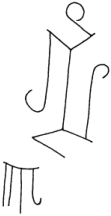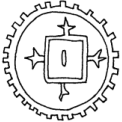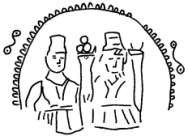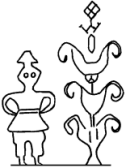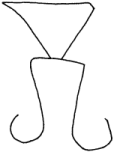Some Remarks on the Scythian and Sarmatian Religion, Symbols etc. (Sergei V. Rjabchikov Krasnodar, Russia)
Some Remarks on the Scythian and Sarmatian Religion
Sergei V. Rjabchikov
Krasnodar, Russia
<srjabchikov@hotmail.com>
Copyright � Sergei V. Rjabchikov, 2002. All rights reserved.
Published 18 April 2002 Last posted 02 January, 2005
Here I investigate several Scythian/Sarmatian artifacts and religious inscriptions. Besides, parallels from the Slavonic world are offered.
- A Scythian wooden sarcophagus was discovered in a stone sepulchre of a barrow called �Three Brothers� near ancient Panticapeum, the capital of the Kingdom of the Bosporus (Kerch, the Crimea, Ukraine) (Bessonova 1971). It was dated to the second half of the 4th century B.C. A Scythian skilled workman used Greek letters as marks on the sarcophagus (Bessonova 1971: 218, figure 5). But three marks are not the Greek letters, see figure 1.
FIGURE 1
![]()
The first sign corresponds to the early Slavonic letter zh (Rjabchikov 1998a: 23, table 1; 1998b: 5-6, table 1). The same sign is presented in a Scythian/Sarmatian record on a Greek vessel of the 4th century B.C that was discovered at the village Starotitarovskaya, the Taman� peninsula (the Krasnodar region, Russia) (Rjabchikov 2000a). The second sign represents four lines and denotes �four�. A kindred sign � three lines � denotes �three� in the Starotitarovskaya inscription. The third sign corresponds to Scythian/Sarmatian signs 09 se inscribed in particular on two weights of spinning-wheels from the Kingdom of the Bosporus that are exhibited in the Taman� Archaeological Museum (the village Taman�, the Krasnodar region, Russia) (1). So one can suppose that the Scythians and Sarmatians used not only the syllabic script based on Linear A (B) (Rjabchikov 2000b), but also the letters of the Greek alphabet as well as some syllables and determinatives. Two marks of the Scythian coffin are combinations of letters TA and TM. It is possible that they are the Scythian/Sarmatian words ta, tama meaning �the sun; fire� and �darkness� respectively (Rjabchikov 2001a). In my opinion, these words are related to the Scythian religious beliefs.
- A bronze artifact was discovered on the Taman� peninsula and is exhibited in the Taman� Archaeological Museum, see figure 2.
część 1: On Scythian, Sarmatian and Meotian Records about Thunderstorm
część 2:On Some Scythian and Sarmatian Symbols
część 3: Some Remarks on the Scythian and Sarmatian Religion
część 4: Remarks on the Scythian, Sarmatian and Meotian Beliefs
część 5: The Scythian and Sarmatian Sources of the Russian Mythology and Fairy-Tales
część 3: ciąg dalszy ze strony tytułowej: Some Remarks on the Scythian and Sarmatian Religion
| FIGURE 2
It was dated to the 2nd century A.D. This specimen represents two signs 59-33 Tar(a). In fact, it is the name of the Scythian/Sarmatian sun and thunder god Targitai (the Indo-Aryan god Indra), cf. Old Indian tara �fire; horse; carrying across; saviour; protector; clean; clear�, Russian tarashchit� �to goggle�, tarovaty �generous�, natoret� �to become skilled� (Rjabchikov 2001b, 2001c). The name of this deity is preserved in the name of the ancient Tamatarha (Tama-Tarha) on the Taman� peninsula. Several symbols are engraved on a rock near the village Uytash, Republic of Dagestan, Russia (Markovin 1970: 96, figure 37), see figure 3.
FIGURE 3
Here one can distinguish signs 59-33 Tar(a) and a stylised drawing of a pair of horses. On the other hand, a pair of horses � signs of the sun � is associated with the god Indra according to Old Indian hymns of Rigveda (II, 11: 6, 7). Moreover, the word 76 09 rase is taken down under the examined segment. This word is comparable with Old Indian roca �shining; radiant; one who lightens or makes bright�, ruc �to shine�, rucya �shining�. 3. A compound symbol is represented on a Sarmatian mirror (Melyukova 1989: 385, table 80 [40]), see figure 4.
FIGURE 4
Here a hut (Baba-Yaga�s hut in Russian fairy-tales) with four chicken legs is located in a circle with 27 rays (it is a solar sign). The wordplay is quite possible: cf. Old Indian hat �to shine; to be bright�, Russian hata �hut�. In my opinion, Tabiti, a Scythian/Sarmatian goddess of the sun, fire and hearth, corresponds to the characters Baba-Yaga �The Old Woman Yaga�, Rozhanitsa �The Bearing Woman� and Makosh� (Ma kosh�) �The Solar Transport/Army� in the Russian mythology (Rjabchikov 2001c). The latter goddess is �the mother of harvest� as well (Rybakov 1987: 126). The Scythian/Sarmatian goddess Tabiti is a female form of the Indo-Arian fire god Agni �Fire�; in accordance with the Indo-Aryan beliefs, this god is situated in the three spheres of the Universe (in sky; in the chthonic water; among people) at the same time (Raevsky 1977: 107, 119-20; 1994: 204-5). The circle with 27 rays of figure 4 is a key to the Russian mysterious term Tridevyatoe Tsarstvo �The 3-9th Kingdom� where Baba-Yaga lives according to Russian fairy-tales. Number 9 is a Russian sacral sign associated with Slavonic pagan sacrifices (Rybakov 1987: 140-2); on the other hand, number 3 is a symbol of the absolute perfection and superiority (Toporov 1992a: 630). Number 27 is obtained by multiplying number 9 by number 3. Several symbols are engraved on both sides of two Scythian sacrificial bronze knives of the 6th century B.C. which were discovered in a Scythian barrow known as the Repyakhovskaya Grave, Ukraine (Ilinskaya, Mozolevsky and Terenozhkin 1980: 49-51, figure 23). Let us examine signs of the reverse side of the second knife (Ilinskaya, Mozolevsky and Terenozhkin 1980: 50, figure 23 [4]), see figure 5.
FIGURE 5
There are six sections here. The 6th (upper) and 5th sections contain several vertical lines between two horizontal lines. I think that these signs mean �sky� (Rjabchikov 2001c, 2001d). The 4th section contains a cross which reads ay �egg; the World Tree; the sun; life, vitality; vigour; long life�. The 3rd and 2nd sections contain signs �sky�, too. The 1st section includes two wavy lines. I believe that they denote the ideas �water; rain�, their figurative meanings are �new life�, �fertility� and �abundance�. Furthermore, these symbols may be connected with the Scythian fire god Agni; this god incarnated in the sword is known as Ares in the History of Herodotus (IV, 59, 62) (2). Agni was born and lives partly in the water. Per Herodotus (The History IV, 62), the Scythians sacrificed horses, cattle, men to this deity; the persons were slaughtered. It is safe to assume that knives mentioned above were used in such sacrifices. Therefore it comes as no surprise that in specific cases the Russian character Baba-Yaga is the goddess of death (3). In a Russian fairy-tale there is an archaic motif of a possible sacrifice of a kid/goat (the boy Ivanushka) associated with ideas �fires�, �cauldrons�, �knives� (Toporov 1991: 663). Moreover, the knife is an attribute of the witch; the knife and victim bring down the milk consisting of the light and rain to the earth in the Russian folklore (Afanasiev 1996: 60, 72). Let us examine signs engraved on a Scythian sword (Melyukova 1964: table 15 [1]), see figure 6.
FIGURE 6
Here three signs 33 ra are presented. I believe that the word *ra (*rya) is an initial form of the word �the sun; fire�, cf. Old Indian surya, ravi �the sun�, cakra �wheel; circle; circular movement; fiery disk; wheel of the sun�s chariot�, vajra �thunderbolt of the god Indra (4)�, su �to create; to produce�, vi �horse; bird�, purvi �sunrise; east; the sun�, Russian bury �brown�, English burn, Old Indian caks �to become visible; to appear; to see; to look�, Old Indian vaj �to be strong�. So the three words �the sun; fire� on the sword denote the three conditions of the Indo-Arian god Agni (5). This interpretation is in excellent agreement with a statement of Valerius Flaccus (Argonautica IV, 54) that armours of warriors of the Scythian mythological king Kolaks are decorated with fires divided into three parts. It is felt that the god Agni in the three fiery conditions corresponds to the three characters Baba-Yaga in some Russian fairy-tales (6). Let us consider the plot depicted on a Scythian brooch which was discovered in the Belyaus burial ground, the Crimea, Ukraine (Dashevskaya 1991: 121, table 65 [1b]), see figure 7.
FIGURE 7
This artifact is severely damaged, so it is natural that some details of the picture are lost. A goddess holds three round things (fires) at the left; a god holds a torch at the right. This drawing represents the Scythian deities of the sun, fire and hearth. They are situated in a circle with a number of rays (it is a symbol of the sun). Two signs 33 ra �the sun; fire� (perhaps the three signs originally) are inscribed, too. It is interesting to study in this connection an archaic pattern of a Slavonic embroidery (7) from the Krasnodar region, Russia, see figure 8.
FIGURE 8
This motif is indeed originated from Scythian/Sarmatian times. Here the fire god stands near three signs 33 ra �the sun; fire�. A stylised sword is placed above the fiery signs. Above them there are two Scythian/Sarmatian signs, otherwise a rhomb together with a cross (ay �egg; the World Tree; the sun; life, vitality; vigour; long life�). A cross is incised in a circle on a fragment of an amphora of the 1st century B.C. � 1st century A.D. that was discovered at the village Mikhaylovka, the Crimea, Ukraine (Yemets and Peters 1994: 171, figure 4 [14]; 173); it is the Scythian/Sarmatian word ay �egg; the World Tree; the sun; life, vitality; vigour; long life� together with the determinative �the sun� (8). I suppose that the symbols of the Kuban embroidery are relevant to wedding rites. A unique burial of a Sarmatian priestess of the 1st century A.D. was discovered in a barrow known as the Sokolovaya Grave, Ukraine (Kovpanenko 1986: 13, 23, 25). As has been shown, the priestess wore three necklaces. Some other artifacts are also of interest. I think that a statuette of a woman in childbirth (cf. the name of the Old Russian pagan goddess Rozhanitsa �The Bearing Woman�) and a knife with a tip in ring form (9) are symbols of the fire deity. Let us study a record incised on a Sarmatian vessel (censer?) from this burial (Kovpanenko 1986: 60, figure 61), see figure 9.
FIGURE 9
The inscription contains a wavy sign, sign 01 da, three wavy signs, signs 72 be and 45 de. The words da and de are associated with Old Indian da �giving; giver; heat�, Russian dat� �to give�, and the word be signifies �beat�, cf. Scythian *biti �beating� (10), Russian bit� �to beat�. This text may be dedicated to the Scythian/Sarmatian deities of the fire and sky. Now one can read a sign engraved on a statue of Scythian/Sarmatian times that is exhibited in the Museum of History and Local Lore of the village Grigoropolisskaya (the Stavropol region, Russia) (11), see figure 10.
FIGURE 10
It is sign 33 ra �the sun; fire�. The statue represents a woman with big breasts decorated with three necklaces. It is reasonably safe to suggest that this is an image of the Scythian/Sarmatian goddess Tabiti; in Russian fairy-tales the personage Baba-Yaga has big breasts, too (12). I conclude that Tabiti is the goddess of fertility. On the other hand, it is common knowledge that the Indo-Arian god Agni is a patron of wedding and childbirth (Afanasiev 1996: 336). A compound symbol is engraved on a slab of a granary from Panticapeum (Solomonik 1983: 88-9, figure 4), see figure 11.
FIGURE 11
The signs read 33 72 ra be �the sun/fire � the beat/thunder� (13). The text describes Tabiti (�the mother of harvest� in this context) living in heaven. Zeus (the god of the sky) and Hestia (the goddess of the fire, hearth and home) were patrons of a Scythian king according to the History of Herodotus (IV, 127). 4. Let us consider a compound symbol incised on a fragment of a red-lacquered plate from Tanais, the Kingdom of the Bosporus (the Rostov-on-Don region, Russia) (Shelov 1972: 240, the middle figure), see figure 12.
FIGURE 12
This word reads 12-54-33 sovara, cf. Old Indian svaru �arrow; sunshine; thunderbolt; sacrifice�, it is an epithet of the god Targitai (Indra) (14). Now let us consider a sign presented on a Sarmatian bronze arrow-head (Smirnov 1984: 25, figure 6 [2L]), see figure 13.
FIGURE 13
It is a cross that reads ay �egg; the World Tree; the sun; life, vitality; vigour; long life�, cf. Old Indian svaru �arrow; sunshine; thunderbolt; sacrifice�, bana �arrow�, bhanu �the sun; brightness; light or ray of light�, bhana �light; lustre� (15). On the other hand, in the Russian beliefs the arrow correlates with the solar symbolism (Afanasiev 1996: 146, 166). A Scythian golden figurine which represents two men shooting arrows is dated to the 4th century B.C. (Kryzhitsky 1986: photo). Common symbols are depicted on cloths of both personages: they are sign 33 ra �the sun; fire� and several crosses ay �egg; the World Tree; the sun; life, vitality; vigour; long life�. It immediately follows that both warriors are brothers twins known as Agni and Indra in the Indo-Arian mythology. 5. Let us consider signs depicted on a Scythian anthropoid stele discovered at the Zavetnoe ancient settlement, the Crimea, Ukraine (Dashevskaya 1991: 98, table 42 [10]), see figures 14 and 15.
FIGURE 14
FIGURE 15
The word 33 05 raja means �king�, the word 01 da means �giving; giver; heat�, cf. Old Indian raja �king�, da �giving; giver; heat�. I think that this stele is an image of the Scythian god Ares (Agni) or Targitai (Indra). This deity corresponds to the Old Russian pagan god Dazh�bog known as �the Sun-king� in an Old Russian tradition (16). 6. Several signs are represented on a Sarmatian mirror (Melyukova 1989: 385, table 80 [46]), see figure 16.
FIGURE 16
I read the name 12-12 Soso �The Very Bright (Sun)�, otherwise the name of the Alanian (Sarmatian) god Soslan (Scythian Targitai, Indo-Aryan Indra) (17) together with the determinative �round� (the sun) and three words 77 ga �bull; cow�, cf. Old Indian go �bull; cow�. According to the Indo-Aryan mythology, the god Indra is a patron of cows; per Herodotus (The History IV, 8), the Scythian god Targitai (Heracles) carried off bulls. Let us examine symbols engraved on an Alanian mirror that was discovered at Jean-Fat, France (Kuznetsov 1996: 73, figure 1 [5]), see figure 17.
FIGURE 17
One can distinguish the name 12-12 Soso �The Very Bright (Sun)� (Soslan), the three lines (it is the name the Indo-Arian god Trita (18) = Indra) which are situated in a place limited by a wavy border. This story is preserved in an Ossetic myth about the hostility between the characters Syrdon (cf. Ossetic danu �water; river�, Old Indian danu �trickling liquid; stream�) and Soslan (19).
NOTES 1. See Rjabchikov 2001a: figure 7. 2. See Rjabchikov 1999. 3. See Ivanov and Toporov 1991. 4. It is conceivable that the name Indra comes from Old Indian indu �bright drop; spark; drop; juice of the Soma plant; the moon� and *ra �the sun; fire�. 5. See also Rjabchikov 2001e. Some Old Indian terms also reflect these religious ideas. Old Indian usoraga �morning light; dawn� includes *ra �the sun; fire�, cf. Old Indian usa �morning light; dawn�. Old Indian ratri �night; darkness of night� comes in my opinion from the name of the condition of the sun (*ra �the sun; fire�) that is situated in the chthonic water (cf. Old Indian tri �three�; so it is the third condition). It is well to bear in mind that the sun is shown in three positions � in the morning, afternoon and evening � on some specimens of the Slavonic decorative art (Rybakov 1987: 468-70, 501, 503). Three sun signs may describe three conditions of the fire deity in Sarmatian records (Rjabchikov 2001b: figure 7; 2001d: figure 35). 6. See Rjabchikov 2001a. 7. It is housed in the department of the folklore and ethnography of the Kuban Cossack Chorus (Krasnodar, Russia). 8. See also Anfimov 1977: 118. 9. See Rjabchikov 2001f. 10. See Trubachev 1977: 19. 11. The field materials of the Kuban folkloric-ethnographic expedition in 1999: the video tape no. I/87 in the archives of the department of the folklore and ethnography of the Kuban Cossack Chorus. 12. See Ivanov and Toporov 1991. 13. See Rjabchikov 2001e. 14. See Rjabchikov 2001b. Cf. also the name Svarog of the Old Russian pagan god of the sky. 15. See also Rjabchikov 2001g. 16. Cf. also Afanasiev 1996: 308; Belyakova 1995: 92. 17. See Rjabchikov 2001h. 18. This name signifies �Third� (Toporov 1992b, 1992c). 19. See Kaloev 1992.
REFERENCES
Afanasiev, A.N., 1996. Proiskhozhdenie mifa. Stat�i po fol�kloru, etnografii i mifologii. Moscow: Indrik. Anfimov, N.V., 1977. Religiozye verovaniya u meotov. In: N.V. Anfimov and P.U. Autlev (eds.) Sbornik trudov po arkheologii Adygei. Maykop: Adygeysky Nauchno-Issledovatel�sky Institut ekonomiki, yazyka, literatury i istorii, pp. 111-28. Belyakova, G.S., 1995. Slavyanskaya mifologiya. Moscow: Prosveshchenie. Bessonova, S.S., 1971. Rekonstruktsiya derevyannogo sarkofaga iz Trekhbratnykh kurganov. Sovetskaya arkheologiya, 4: 215-21. Dashevskaya, O.D., 1991. Pozdnie skify v Krymu. Arkheologiya SSSR. Svod arkheologicheskikh istochnikov. Vol. D 1-7. Moscow: Nauka. Ilinskaya, V.A., Mozolevsky, A.I. and A.I. Terenozhkin, 1980. Kurgany VI v. do n.e. u s. Matusov. In: A.I. Terenozhkin (ed.) Skifiya i Kavkaz. Kiev: Naukova dumka, pp. 31-63. Ivanov, V.V. and V.N. Toporov, 1991. Baba-yaga. In: S.A. Tokarev (ed.) Mify narodov mira. Vol. 1. Moscow: Sovetskaya Entsiklopediya, p. 149. Kaloev, B.A., 1992. Soslan. In: S.A. Tokarev (ed.) Mify narodov mira. Vol. 2. Moscow: Sovetskaya Entsiklopediya, p. 464. Kovpanenko, G.T., 1986. Sarmatskoe pogrebenie I v. n.e. na Yuzhnom Buge. Kiev: Naukova dumka. Kryzhitsky, S.D. (ed.), 1986. Arkheologiya Ukrainskoy SSR. Vol. 2. Skifo-sarmatskaya i antichnaya arkheologiya. Kiev: Naukova dumka. Kuznetsov, V.A., 1996. Alany na Zapade: arkheologicheskaya real�nost� ili mif? Rossiyskaya arkheologiya, 4: 71-9. Markovin, V.I., 1970. Sarmatskaya tamga na skalakh Uytasha (Dagestan). Kratkie soobshcheniya Instituta Arkheologii AN SSSR, 124. Severnoe Prichernomor�e v skifo-sarmatskoe vremya. Mjscow: Nauka, pp. 95-8. Melyukova, A.I., 1964. Vooruzhenie skifov. Arkheologiya SSSR. Svod arkheologicheskikh istochnikov. Vol. D1-4. Moscow: Nauka. Melyukova, A.I. (ed.), 1989. Stepi evropeyskoy chasti SSSR v skifo-sarmatskoe vremya. Moscow: Nauka. Raevsky, D.S., 1977. Ocherki ideologii skifo-sakskikh plemen: Opyt rekonstruktsii skifskoy mifologii. Moscow: Nauka. Raevsky, D.S., 1994. Skifsky panteon: semantika struktury. In: V.Y. Petrukhin (ed.) Istoriko-etnograficheskie issledovaniya po fol�kloru. Sbornik statey pamyati Sergeya Alexandrovicha Tokareva. Moscow: Vostochnaya Literatura, pp. 198-213. Rjabchikov, S.V., 1998a. Tainstvennaya Tmutarakan�. Krasnodar: Torgovo-promyshlennaya palata Krasnodarskogo kraya. Rjabchikov, S.V., 1998b. Drevnie texty slavyan i adygov. Krasnodar: Torgovo-promyshlennaya palata Krasnodarskogo kraya. Rjabchikov, S.V., 1999. The Scythians, Sarmatians, Meotians, Russians and Circassians: Interpretation of the Ancient Cultures. �THE SLAVONIC ANTIQUITY� Home Page: <http://public.kubsu.ru/~usr02898/sl2.htm>. Rjabchikov, S.V., 2000a. The Proto-Slavonic Record on the Fragment of a Vessel from the Taman� Archaeological Museum. �THE SLAVONIC ANTIQUITY� Home Page: <http://public.kubsu.ru/~usr02898/sl26.htm>. Rjabchikov, S.V., 2000b. The Preliminary Report on the Decipherment of the Proto-Slavonic Writing System. �THE SLAVONIC ANTIQUITY� Home Page: <http://public.kubsu.ru/~usr02898/sl27.htm>. Rjabchikov, S.V., 2001a. The Scythian/Sarmatian Influence on the Slavonic Mythology and Decorative Art. �THE SLAVONIC ANTIQUITY� Home Page: <http://public.kubsu.ru/~usr02898/sl37.htm>. Rjabchikov, S.V., 2001b. The Interpretation of Some Sarmatian Motifs and Inscriptions. �THE SLAVONIC ANTIQUITY� Home Page: <http://public.kubsu.ru/~usr02898/sl30.htm>. Rjabchikov, S.V., 2001c. The Scythian and Sarmatian Sources of the Russian Mythology and Fairy-Tales. AnthroGlobe Journal: </docs/Sergei/scythian-sarmatian-Russian-mythology-fairytales.htm>. Rjabchikov, S.V., 2001d. The Interpretation of Scythian, Sarmatian and Meotian-Sarmatian Motifs and Records. �THE SLAVONIC ANTIQUITY� Home Page: <http://public.kubsu.ru/~usr02898/sl29.htm>. Rjabchikov, S.V., 2001e. The Interpretation of the Record on a Sarmatian Sword from Thrace. �THE SLAVONIC ANTIQUITY� Home Page: <http://public.kubsu.ru/~usr02898/sl32.htm>. Rjabchikov, S.V., 2001f. On the Symbolism of Sarmatian Daggers and Swords. �THE SLAVONIC ANTIQUITY� Home Page: <http://public.kubsu.ru/~usr02898/sl33.htm>. Rjabchikov, S.V., 2001g. The Scythian Records on Coins of the Scythian King Skilur. �THE SLAVONIC ANTIQUITY� Home Page: <http://public.kubsu.ru/~usr02898/sl38.htm>. Rjabchikov, S.V., 2001h. The Interpretation of a Scythian Solar Myth. �THE SLAVONIC ANTIQUITY� Home Page: <http://public.kubsu.ru/~usr02898/sl43.htm>. Rybakov, B.A., 1987. Yazychestvo Drevney Rusi. Moscow: Nauka. Shelov, D.B., 1972. Tanais i Nizhni Don v pervye veka nashey ery. Moscow: Nauka. Smirnov, K.F., 1984. Sarmaty i utverzhdenie ikh politicheskogo gospodstva v Skifii. Moscow: Nauka. Solomonik, E.I., 1983. Neskol�ko pamyatnikov s sarmatskimi znakami. In: T.N. Vysotskaya (ed.) Naselenie i kul�tura Kryma v pervye veka n.e. Kiev: Naukova dumka, pp. 80-95. Toporov, V.N., 1991. Kozel. In: S.A. Tokarev (ed.) Mify narodov mira. Vol. 1. Moscow: Sovetskaya Entsiklopediya, pp. 663-4. Toporov V.N., 1992a. Chisla. In: S.A. Tokarev (ed.) Mify narodov mira. Vol. 2. Moscow: Sovetskaya Entsiklopediya, pp. 629-31. Toporov V.N., 1992b. Trita. In: S.A. Tokarev (ed.) Mify narodov mira. Vol. 2. Moscow: Sovetskaya Entsiklopediya, pp. 525-6. Toporov V.N., 1992c. Trita, Frita. In: S.A. Tokarev (ed.) Mify narodov mira. Vol. 2. Moscow: Sovetskaya Entsiklopediya, p. 526. Trubachev, O.N., 1977. Lingvisticheskaya periferiya drevneyshego slavyanstva. Indoariytsy v Severnom Prichernomor�e. Voprosy yazykoznaniya, 6: 13-31. Yemets, I.A. and B.G. Peters, 1994. Graffiti iz poseleniya u s. Mikhaylovka. Rossiyskaya arkheologiya, 2: 164-78. |
|


